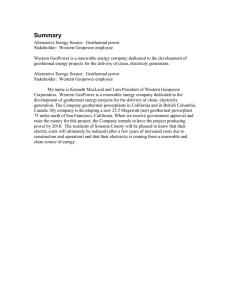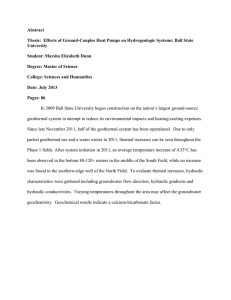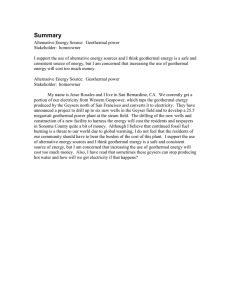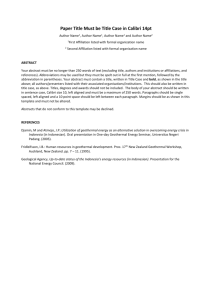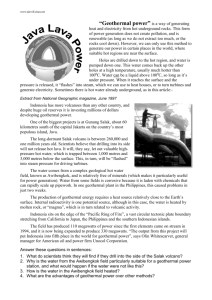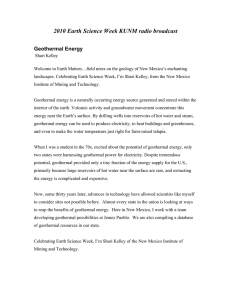Challenges and Prospects of Geophysical Exploration of Geothermal Abraham Musa Zira
advertisement
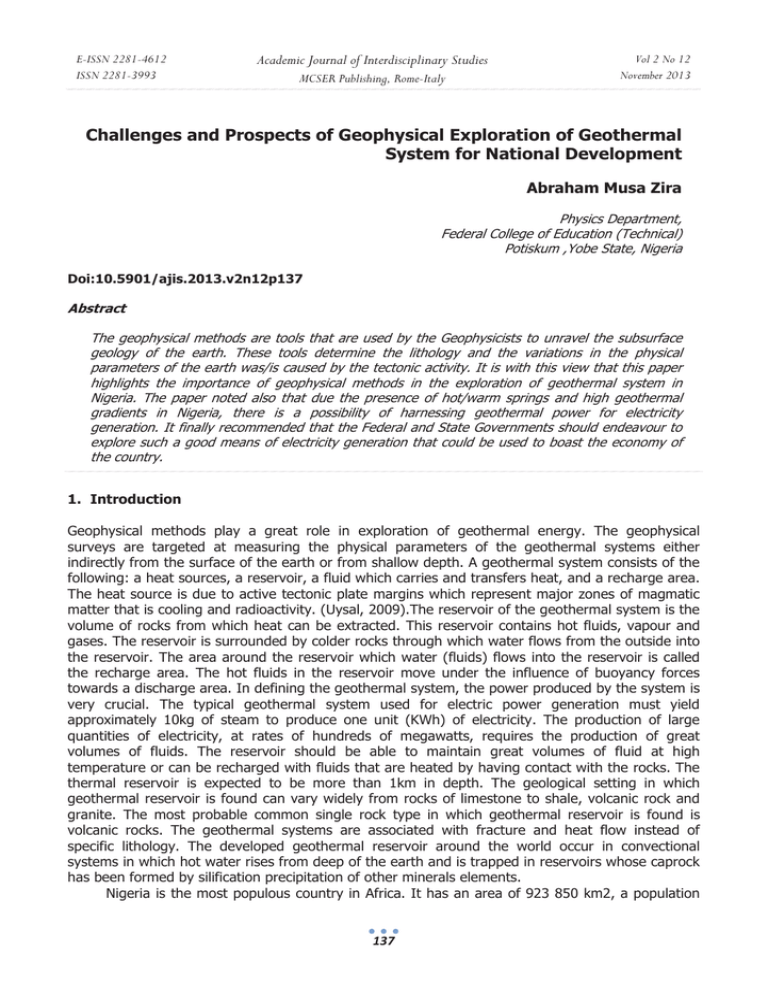
E-ISSN 2281-4612 ISSN 2281-3993 Academic Journal of Interdisciplinary Studies MCSER Publishing, Rome-Italy Vol 2 No 12 November 2013 Challenges and Prospects of Geophysical Exploration of Geothermal System for National Development Abraham Musa Zira Physics Department, Federal College of Education (Technical) Potiskum ,Yobe State, Nigeria Doi:10.5901/ajis.2013.v2n12p137 Abstract The geophysical methods are tools that are used by the Geophysicists to unravel the subsurface geology of the earth. These tools determine the lithology and the variations in the physical parameters of the earth was/is caused by the tectonic activity. It is with this view that this paper highlights the importance of geophysical methods in the exploration of geothermal system in Nigeria. The paper noted also that due the presence of hot/warm springs and high geothermal gradients in Nigeria, there is a possibility of harnessing geothermal power for electricity generation. It finally recommended that the Federal and State Governments should endeavour to explore such a good means of electricity generation that could be used to boast the economy of the country. 1. Introduction Geophysical methods play a great role in exploration of geothermal energy. The geophysical surveys are targeted at measuring the physical parameters of the geothermal systems either indirectly from the surface of the earth or from shallow depth. A geothermal system consists of the following: a heat sources, a reservoir, a fluid which carries and transfers heat, and a recharge area. The heat source is due to active tectonic plate margins which represent major zones of magmatic matter that is cooling and radioactivity. (Uysal, 2009).The reservoir of the geothermal system is the volume of rocks from which heat can be extracted. This reservoir contains hot fluids, vapour and gases. The reservoir is surrounded by colder rocks through which water flows from the outside into the reservoir. The area around the reservoir which water (fluids) flows into the reservoir is called the recharge area. The hot fluids in the reservoir move under the influence of buoyancy forces towards a discharge area. In defining the geothermal system, the power produced by the system is very crucial. The typical geothermal system used for electric power generation must yield approximately 10kg of steam to produce one unit (KWh) of electricity. The production of large quantities of electricity, at rates of hundreds of megawatts, requires the production of great volumes of fluids. The reservoir should be able to maintain great volumes of fluid at high temperature or can be recharged with fluids that are heated by having contact with the rocks. The thermal reservoir is expected to be more than 1km in depth. The geological setting in which geothermal reservoir is found can vary widely from rocks of limestone to shale, volcanic rock and granite. The most probable common single rock type in which geothermal reservoir is found is volcanic rocks. The geothermal systems are associated with fracture and heat flow instead of specific lithology. The developed geothermal reservoir around the world occur in convectional systems in which hot water rises from deep of the earth and is trapped in reservoirs whose caprock has been formed by silification precipitation of other minerals elements. Nigeria is the most populous country in Africa. It has an area of 923 850 km2, a population 137 E-ISSN 2281-4612 ISSN 2281-3993 Academic Journal of Interdisciplinary Studies MCSER Publishing, Rome-Italy Vol 2 No 12 November 2013 of 82 390 000 and thus a mean population density of 89 persons/km2. It extends between the latitudes 4°16'N (at the tip of the Niger Delta) and 13°52'N, and between longitudes 2°49'E (on the Okpara River) and 14°37'E (on the El Beid River). It has maximum dimensions of 1200 km from east to west and 1000 km from north to south and is bounded by Cameroon and Chad in the east, Niger in the north and Benin in the west. The coastline is 780 km long, excluding the indentations of Lagos Lagoon, the Niger Delta and the Cross River Estuary, which add at least 1300 km to this. The principal physiographic feature is the Niger/Benue River system which separates three highland blocks. The southern coastline is dominated by the delta of the Niger River (36 260 km2), and inland from this the coastal plain, less than 100 m, is 75-125 km wide, except in the southeast where it contracts to 50 km. Lowlands below the 100 m contour accompany the Niger inland for 400 km to its confluence with the Benue. From here the lowlands continue northeast up the Benue for a further 550 km, and northwest up the Niger for 210 km. The lower Niger system forms a great Y shape, with the delta at the base of the Y, the Niger River forming the stem and left hand branch and the Benue, the right hand branch. The Jos Plateau (1200 m as!), which rises to occasional high peaks, e.g. 1698 m at Wadi Hill and 1781 m at Shere Hill, lies between the arms of the Y and continues northwestwards as the Funtua Plateau. To the east of the Y are the mountains along the border with Cameroon, which rise to 2419 m asl at Chappal Wade, the highest point in Nigeria. To the west of the Y are the Yoruba Highlands. Other lowland areas are the Sokoto (Rima) Basin in the northwest, and around Lake Chad in the northeast. Drainage from the Jos-Funtua Plateau is either northeastwards to Lake Chad, via the Komadugu Yobe, or northwest, south or southwest to the Niger/Benue River. From most of the eastern highland block along the Cameroon frontier, drainage is northeastwards to the Benue, but the southernmost ranges drain to the Bight of Biafra via the Cross River. The Yoruba Highlands drain northeastwards to the Niger or southwards to the Bight of Benin. 2. Climate Mean annual rainfall decreases progressively in passing inland, but it is generally wetter in the east than the west. On the coast at the border with Benin, mean annual rainfall is close to 1750 mm, but this rises to 1836 mm at Lagos (6°27'N/3°34'E) and to 3800 mm at Forcados (5°21'N/5'25'E) on the Niger Delta but it falls to 2483 mm at Port Harcourt in the eastern delta. Forcados averages 180 rainy days each year and Port Harcourt 170. There is less disparity in rainfall from west to east inland, however. Mean annual rainfall is 1378 mm at Makurdi (7°45'N/8°32'E) on the Benue River, and 1257 mm at Ilorin (8°30'N/4°32'E). In the centre it rises slightly to 1431 mm at Jos (9°55'N/8°53'E), which is situated in a wet pocket, and is 1000 m higher than Makurdi. From here rainfall declines to 865 mm at Kano (12°00'N/8°30'E) and 600 mm at Maiduguri (11°53'N/13°16'E) in the northeast. The wet season is 10-11 months long on the delta, with a short dry period in December or December-January, depending upon station. On the western coast, near Lagos (6°27'N/3°24'E), the three months December-February are dry, and there is often a second dry period in August. In passing inland the August dry period is lost, but the major dry season increases in length and severity. It is 6 months long at Jos and 7 months (October-April) at Kano and 8-9 months long at Lake Chad (September-May). Temperature ranges are lower at the coast than inland. At Lagos the mean monthly temperature of the warmest month is 27°C and that of the coolest month is 24°C, while at Port Harcourt the corresponding figures are 26°C and 24°C. The figures for Jos are 24°C and 20°C, while those for both for Kano and Maiduguri are 31°C and 22°C. The prevailing winds at the coast are from the SW, and these bring the rains to the interior as the intertropical convergence moves north and south. 3. Vegetation The coastal strip is Guinean, and either is, or was once, covered by Guinean rain forest. In passing 138 E-ISSN 2281-4612 ISSN 2281-3993 Academic Journal of Interdisciplinary Studies MCSER Publishing, Rome-Italy Vol 2 No 12 November 2013 north this grades through a Guinean-Soudanian transition zone, which may carry forest, into well wooded Soudanian savannas. Guinean species penetrate far into the savanna zones along the major rivers. 4. Wetlands Coastal wetlands are the most extensive. In the west there are large lagoonal systems with mangrove swamps, palm-pandan swamps and reed swamps. In the east the Niger Delta and Cross Estuary both carry large areas of mangrove forest, and both permanent and seasonally inundated freshwater swamp forest. Inland there are floodplains on many rivers, as a consequence of the increasing seasonality of the rainfall in passing north. For example, although mean annual rainfall is only 653 mm at Maiduguri, some 90% of this falls in two months. In the Soudanian zone, forest on the levees is inundated at the time of flooding, as are broad grasslands behind them. Elsewhere in the north, away from rivers, there are other seasonal wetlands. These are chiefly clay-based pans and ponds which fill with water in most years. Figure 1: Geological setting and location of the major structural units in Nigeria Figure 2: Map of geothermal gradients (°C/100m) within the part of Chad (Borno) Basin. 139 E-ISSN 2281-4612 ISSN 2281-3993 Academic Journal of Interdisciplinary Studies MCSER Publishing, Rome-Italy Vol 2 No 12 November 2013 Figure 3: Map of geothermal gradients (°C/100m) within the part of Iullemmeden basin. 5. Overview of Geophysical Methods Applicable to Geothermal Exploration There are numerous geophysical methods that are employed in the exploration of geothermal systems. The types of geophysical methods are as follow: Magnetotellurics (MT), Audiomagnetotellurics (AMT), Tellurics-Magnetotellurics (T-MT), Control Source Audiomagnetotellurics (CSAMT), Helicopter Electromagnetics (HEM), Time Domain Electromagnetics (TDEM), Vertical Electrical Sounding (VES), Self Potential (SP), Differetial Global Positioning System (dGPS).The geophysical methods can be grouped according to the rock parameter they measure. Resistivity of rocks can be measured using, MT, TDEM, VES, CSAMT, and HEM and measure the following parameters: • Density of rocks is measured using gravity and seismic • Magnetic susceptibility of rocks is measured using magnetic field • Natural electrical voltage is measured using SP method and • Seismic impedance is measured using seismic reflection The physical parameters (temperature, resistivity, density, magnetic susceptibility, and seismic impedance) of rocks provide vital information on the shape size , and depth of the deep geological structures constituting a geological reservoir and the heat source. Thermal surveys can delimit the area of enhanced thermal gradient which is a basic requirement for high-enthalpy geothermal system and define temperature distribution. The information on geothermal fluids in geological structures can be obtained with electrical and electromagnetic surveys since they are more sensitive to fluids pressure especially if salty and has variation in temperature. Generally, resistivity is influenced by porosity saturation. The curie point has the potential of providing information of the existence of a hot rocks mass in the crust. Curie point is a temperature at which a material loses its ferromagnetism due to heat. The depth to the rock that has lost its magnetism due to high-temperature can be determined using magnetic method. Further confirmation can be obtained by P-wave delay and shear wave shadow studies. If a hot fluid emerges at the surface, geochemical surveys provide the most viable indications of reservoir temperatures. The application of geophysical methods depends on the characteristics of the geothermal site to be surveyed. Due to the high cost of geophysical survey, reconnaissance survey is usually encouraged which followed by detail survey. Sometimes different methods are used during detail survey to confirm the results of reconnaissance survey (Alan and Kahan, 200). 140 E-ISSN 2281-4612 ISSN 2281-3993 Academic Journal of Interdisciplinary Studies MCSER Publishing, Rome-Italy Vol 2 No 12 November 2013 6. Geological Setting and Geothermal Energy Implication in Nigeria The Nigerian Precambrain basement complex is exposed on the earth surface within about 48% of the total land area of the country while 52% of the land is covered by Cretaceous to recent sediments deposition in several Basins. The basement complex of the central shield, Southwestern, Southeastern and Eastern margin of Nigeria has three major groups of rocks: 1) Migmatite and Gnesis dominated, 2) Schists with Quartzites and other minor lithologies forming long, narrow North-South trending belts, mainly in the Western part of the country and 3) Intrusive Granitic rocks-Older Granites and Jurassic Younger Granites (Ajibade et al., 1989, Ewa and Schoeneich, 2010). The longest and deepest sedimentary zone which is filled with many kinds of plastics of marine and continental origin trends from Niger Delta in Southwest through Benue Trough towards Northeast Borno (Chad) Basin. The belt has several sub-divisions of Basins related to the crustal stretching and opening-up of the Atlantic Ocean (Gulf of Guinea) and Gondwana break-up during the lower Cretaceous time. The basins is partially interpreted as troughs and rifts which were subjected to tectonic deformations during Cretaceous to Neogene times and affected by magmatic volcanic episodes which resulted in present structural pattern. The deepest Nigerian sedimentary belt is the Niger Delta with a thickness exceeding 9km. Benue Trough consists of lower, middle and upper parts. The lower Benue Trough consists of Anambra Basin Abakaliki Anticlinorium(uplift) while the upper Benue Trough consists of Yola arm and Kerri Kerri Basins which has a thickness close to 6km in some part of the Basins.The Chad Basin is an extension of the Benue Trough and has a thickness of about 4km. The Middle Benue Trough called the Nupe or Bida Basin has a thickness of about 2km and is about 0.5-1km deep. The South-western part of Nigeria has a Basin called Sokoto Basin and has a depth of 1km. The geological structure of any area influences its general distribution of its natural resources including geothermal in the upper crust. Presently there is no much information about geothermal basement rocks in Nigeria. The only source of geothermal information is obtainable from the several warm and hot springs and seepages located within the Benue Trough (Mattick, 1982, Kogbe, 1979). 7. The Justification for Geothermal System Unlike fossil fuel power plants, no smoke is emitted from geothermal power plants since no burning takes place; steam is emitted from geothermal facilities. Gases like nitrous oxide, hydrogen sulphide, sulphur dioxide, carbon dioxide are emitted but are extremely low when compared to fossil fuel emissions. Geothermal systems are environmental friendly unlike fuel plant that causes several and dangerous impacts to an environment like lung irritation, coughing, smog formation, water quality deterioration chest tightness, respiratory illness, ecosystem damage, cancer, atmospheric deposition, global warming which causes melting of polar ice. Geothermal energy provides low cost, reliable, and environmental friendly. When cited it will provide jobs for the massive unemployed graduates in our society and is a means of revamping our economy that is crippled because of shortage of power generation. It will equally generate revenue to the state and federal government. (GEA, 2011) The greater percentage of the power generation in Nigeria is attributed to hydro-power whose site is concentrated in one area (along the river Nile) resulting in long transmission distances and high energy losses and also poses lack of security in case of reduction in hydropower output arising from climatic fluctuations and therefore need to diversify energy sources. To that effect there is need to develop geothermal power in Nigeria to enhance electricity generation which will in turn boast our national economy. 8. Heat from the Earth The earth temperature increases gradually with depth reaching more than 42000c at the center. 141 E-ISSN 2281-4612 ISSN 2281-3993 Academic Journal of Interdisciplinary Studies MCSER Publishing, Rome-Italy Vol 2 No 12 November 2013 Most of this heat is generated by radioactive isotopes. As the heat naturally moves from hotter to cooler regions, so that the earth’s heat flows along a geothermal gradient from the center tothe surface. The earth radiates an estimated of 42x106 megawatts of heat continuously. This heat is not practically captured because it arrives at the surface of the earth at low temperatures. It is only geothermal system that is practically efficient for generating power since it lies with the crust of the earth and it has a high temperature. This magmatically heated geothermal system is driven by partially molten or crystallized which propagates its heat conventionally. The geothermal systems exploration does not offer any threat to our society at all. 9. The Potential Geothermal Areas in Nigeria There are number of sites that indicate the possibility of geothermal system in Nigeria. From the records of the geothermal gradient, it shows that many sites in Nigeria are good for geothermal system which is of course subject to confirmation with geophysical methods. The normal geothermal gradient of the earth is between 2-30c/100m and geothermal gradient above this range is considered to be a good site for geothermal system. The geothermal gradient of Niger Delta ranges from 1.3 to 5.50c/100m. The geothermal gradient of Anambra Basin ranges from 2.5 to 4.90c /100m (Avbovbo, 1978). A similar study of the geothermal gradient of Bida Basin shows that it ranges from 2 to 2.50c/100m. The Borno Basin temperature gradient ranges from 1.1 to 5.90c/100m. The study on of Sokoto Basin has revealed its geothermal gradient to range from 0.9 to 7.60c/100m (Ewa and Schoeneich, 2010). Another indicator that shows the possibility of geothermal system in Nigeria is the presence of hot and warm springs. The following areas have springs that indicate the leakage of geothermal system from the crust: Akiri in Benue State has a hot spring which generate a temperature of about 53.50c Wikki in Yankari Game Reserve in Bauchi State has a warm spring of the temperature of 320c Ruwan Zafi in Adamawa State located in Lamurde generate a temperature of 540c 10. Geothermal Gradient Facts from Bottom Hole Temperature Bottom Hole Temperature (BHT) data from 21 oil wells in the Nigerian sector of the Chad Basin were analyzed and interpreted to investigate the thermal structure of the basin. A regional average geothermal gradient of 3.4°C/100 m geothermal gradients in the range of 3.0 to 4.4 °C/100 m were obtained. The gradients are relatively lower at the Northeast and Southwest axis and maximum at the North-centre. These differences in geothermal gradients may reflect changes in thermal conductivity of rocks, groundwater movement and endothermic reactions during diagenesis. Also the presence of Tertiary intrusive that is prevalent in the basin may be connected with the variations in the computed geothermal gradient values. The study also reveals that sediments with relatively higher geothermal gradients (3.5 to 4.4°C/100 m) mature earlier (low oil window) than those with low gradient values. Thus, under normal circumstances a high geothermal gradient enhances the early formation of oil at relatively shallow burial depths, but it causes the depth range of the oil window to be quite narrow, while low geothermal gradient causes the first formation of oil to begin at fairly deep subsurface levels, but makes the oil window to be quite broad. (Cyril N. Nwankwo* and Anthony S. Ekine, 2009) 11. Conclusion The paper identified some areas in Nigeria that are likely to be a target for geothermal prospects as high temperature gradient of hot and warm springs. The geothermal analysis based on geothermal gradient indicated areas of higher than average gradient values and geothermal anomalies within sedimentary basins. It is possible to conduct more precise study of geothermal gradients if temperature data from oil and gas exploration wells from Benue Trough, Chad and Sokoto basins 142 E-ISSN 2281-4612 ISSN 2281-3993 Academic Journal of Interdisciplinary Studies MCSER Publishing, Rome-Italy Vol 2 No 12 November 2013 are available. Nevertheless, the areas of geothermal anomalies with gradients above 5°C/100m found in the present study might be prospective for geothermal energy utilization. In Nigeria the most needed application of geothermal energy would be production of electricity but the real possibility of that and potential assessment needs further research. The geothermal gradient hot/warm springs mentioned above are good indicators for a possibility of harnessing geothermal power in Nigeria since this will boast the economical power of the country. The Nigerian Federal and State Government should endeavour to take a giant stride to explore such a great means of electricity generation. ( Ewa And Schoeneich, (2010) References Alan,E.M. and Kahan,M.F. (2000): An Introduction to Geological Geophysics, Cambrige University Press,UK. Ajibade,C.A.,Woakes,M.,Rahaman,M.A.(1989): Proterozoic Crustal Development in the Pan_African Regime of Nigeria In: Geology of Nigeria Abiprint and Pak Ltd.,Ibadan Avbovbo,A.A.(1978): Geothermal Gradients in the Southern Nigerian Basin. Bulletin of Canadian Petroleum Geology. Vol.26, No.268-274 Cyril N. Nwankwo* and Anthony S. Ekine(2009): Geothermal gradients in the Chad Basin, Nigeria, from bottom hole temperature logsInternational Journal of Physical Sciences Vol. 4 (12), pp. 777–783, December 2009 ISSN 1992-1950 © 2009 Academic Journals Ewa,K. And Schoeneich,K (2010): Geothermal Exploration in Nigeria, Proceedings World Geothermal Congress 2010 Bali,Indonesia, 25-29 April 2010. Geothermal Energy Association (2011): Geothermal Basics- Environmental Issues and benefits 6.1.41 Kogbe,C.A. (1979): Geology of the Southern Eastern (Sokoto) Sector of the Iullemmeden Basin,Bulletin, Department Geology ABU.Zaria,Nigeria Vol.2 No.1 Mattick,C.A.(1982): Assesment of the Petroleum, coal,and geothermal Resources of the Economic Community of West African State (ECOWAS) region United State Department of the Interior Geological Survey. Uysal, T (2009): Tracing the Origin of Heat Anomalies in Hot Sedimentary Aquifer System in Australia. http://Geothermalenergy centre of Excellence .org 143
